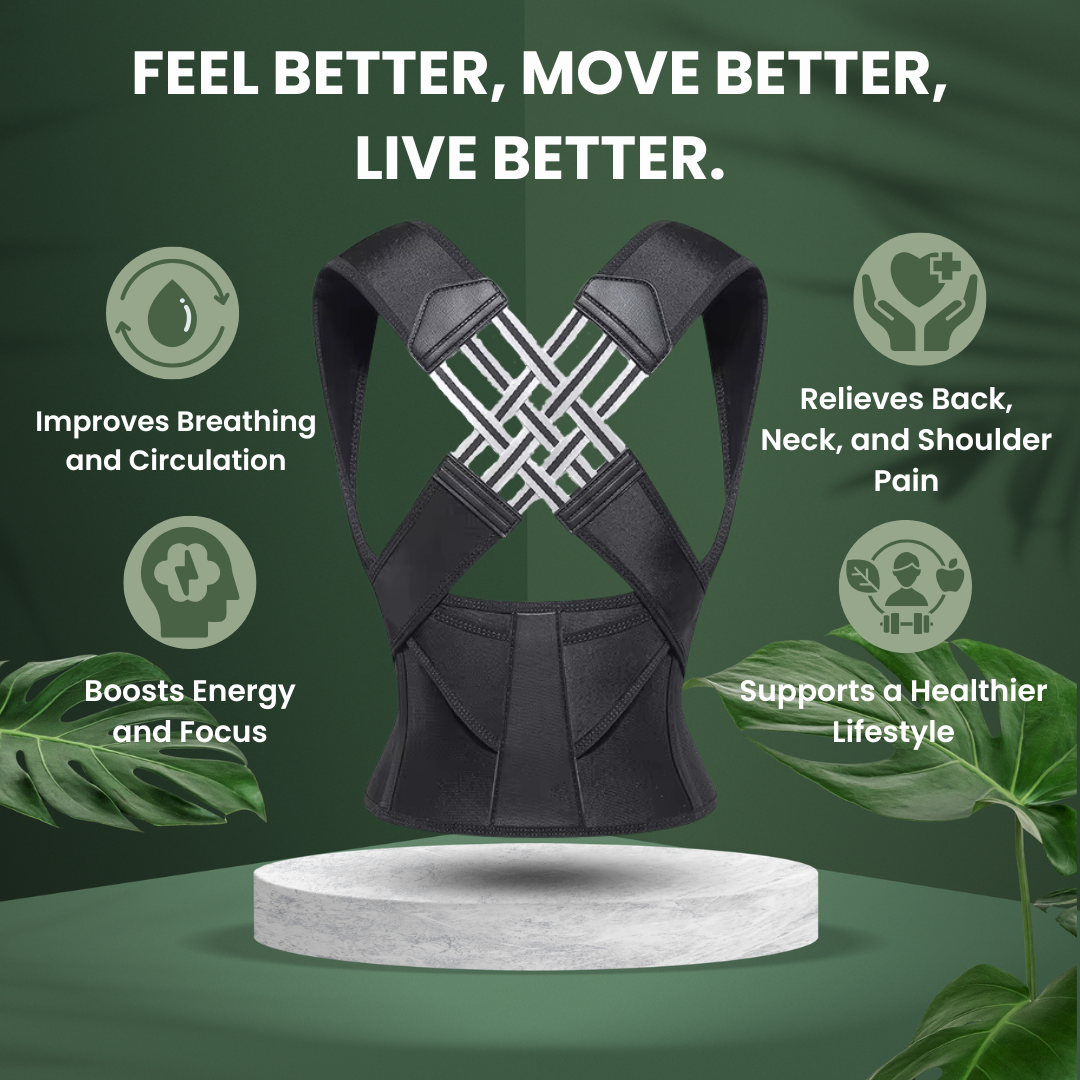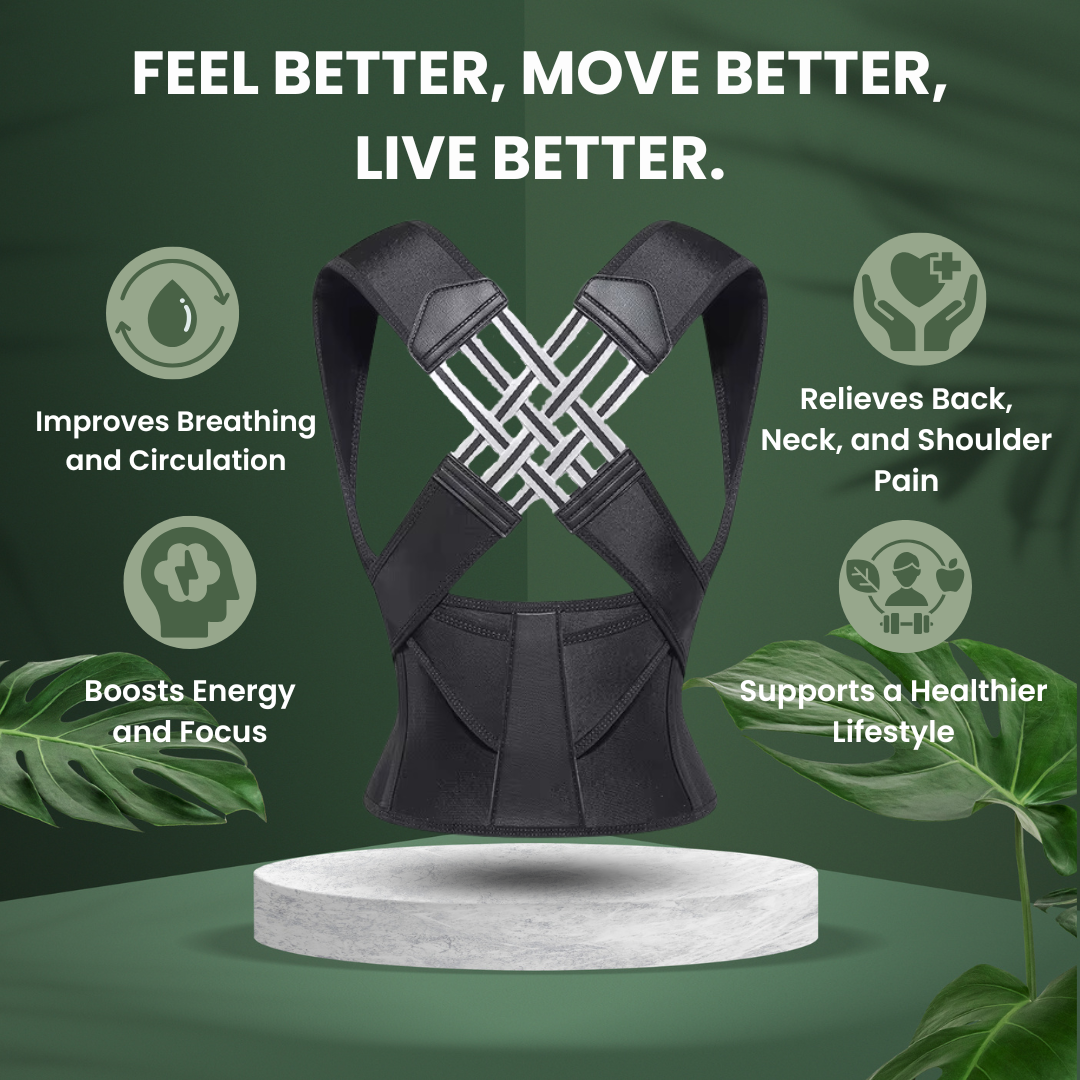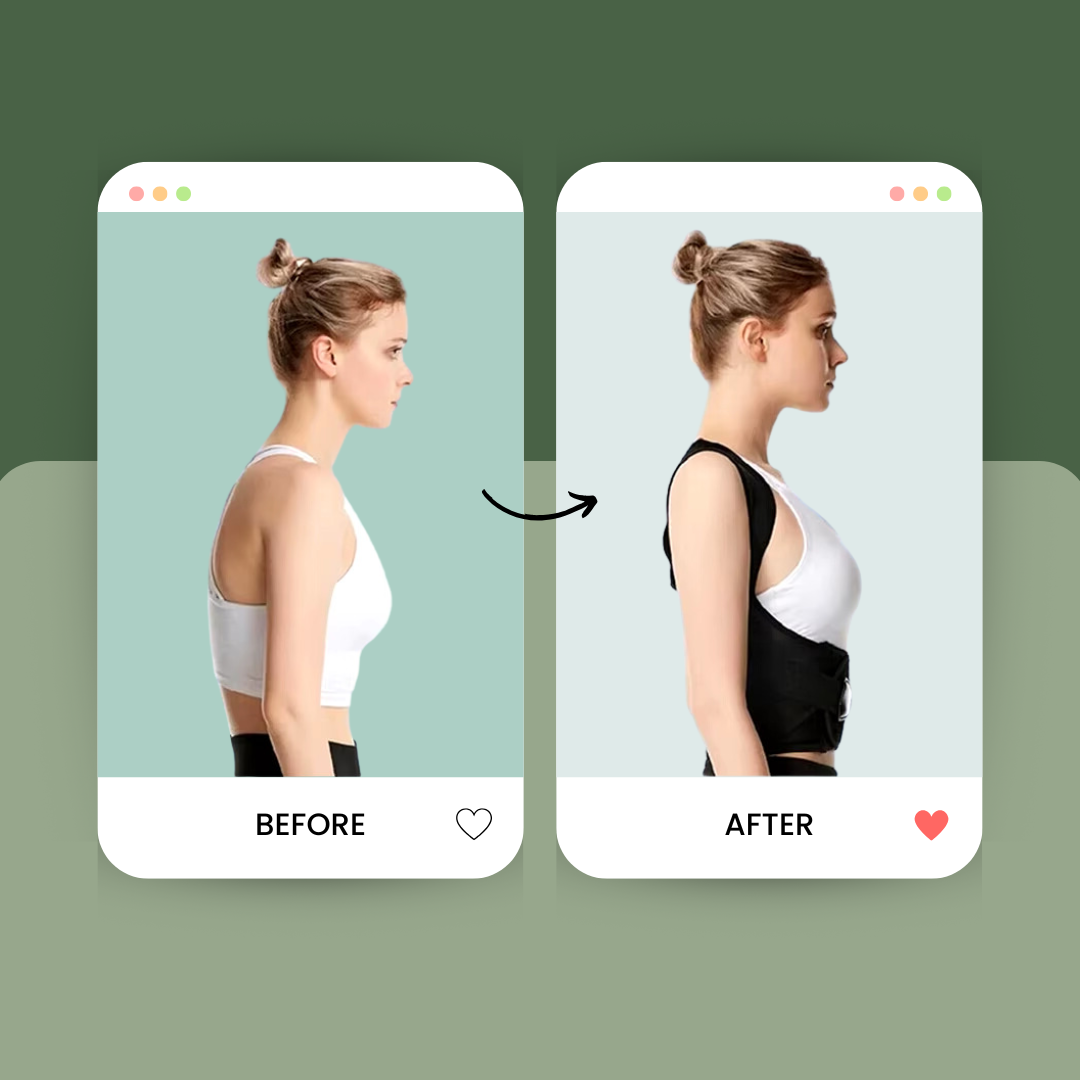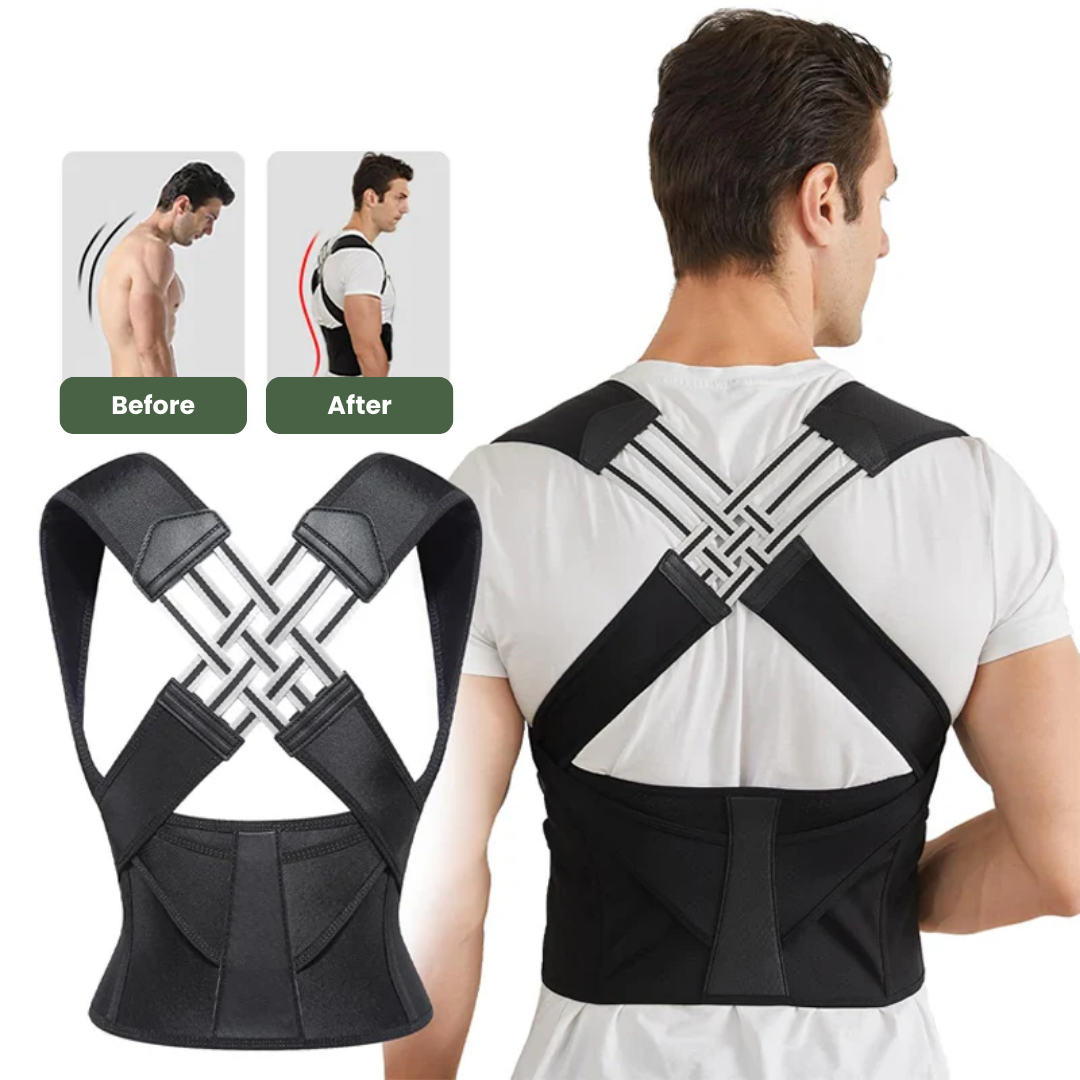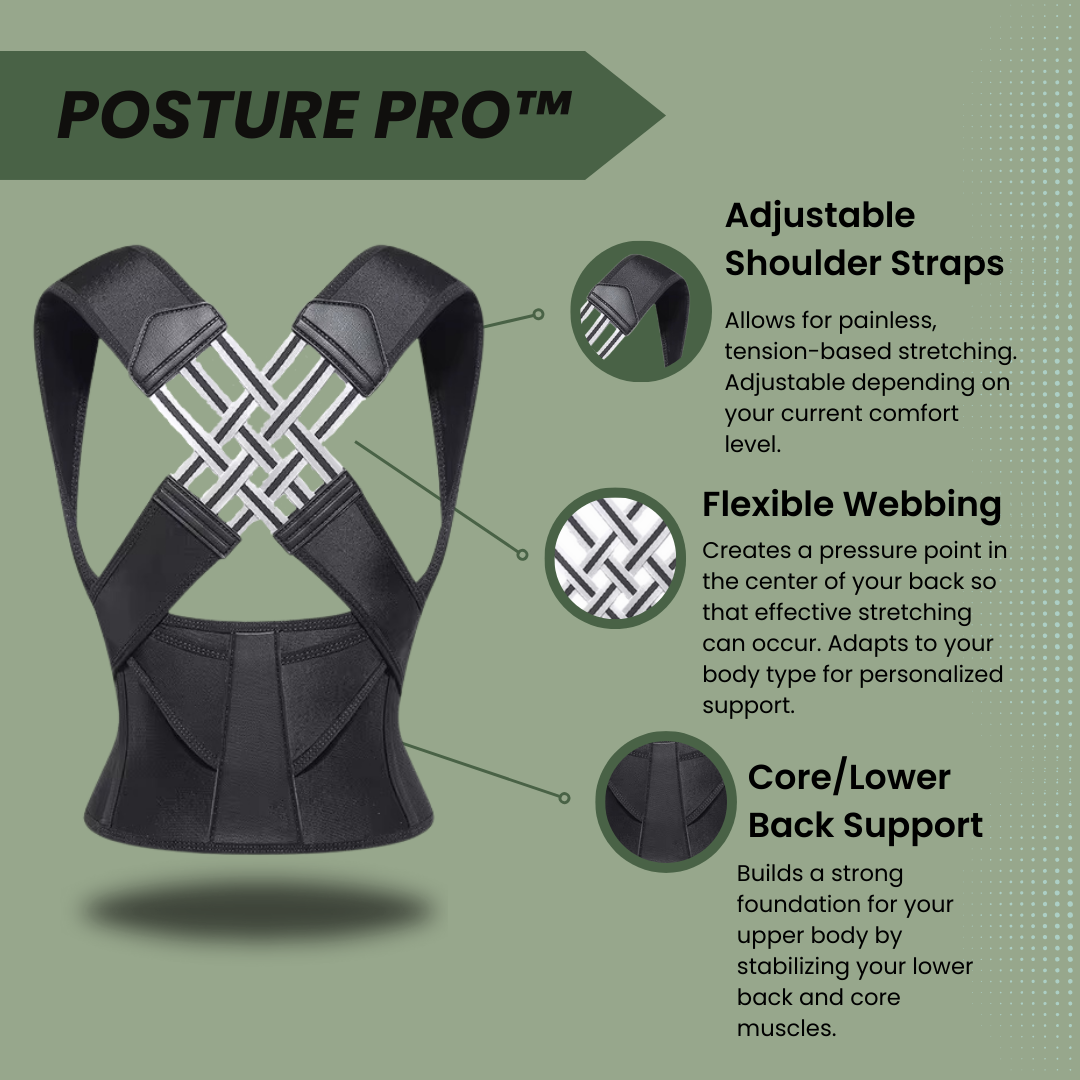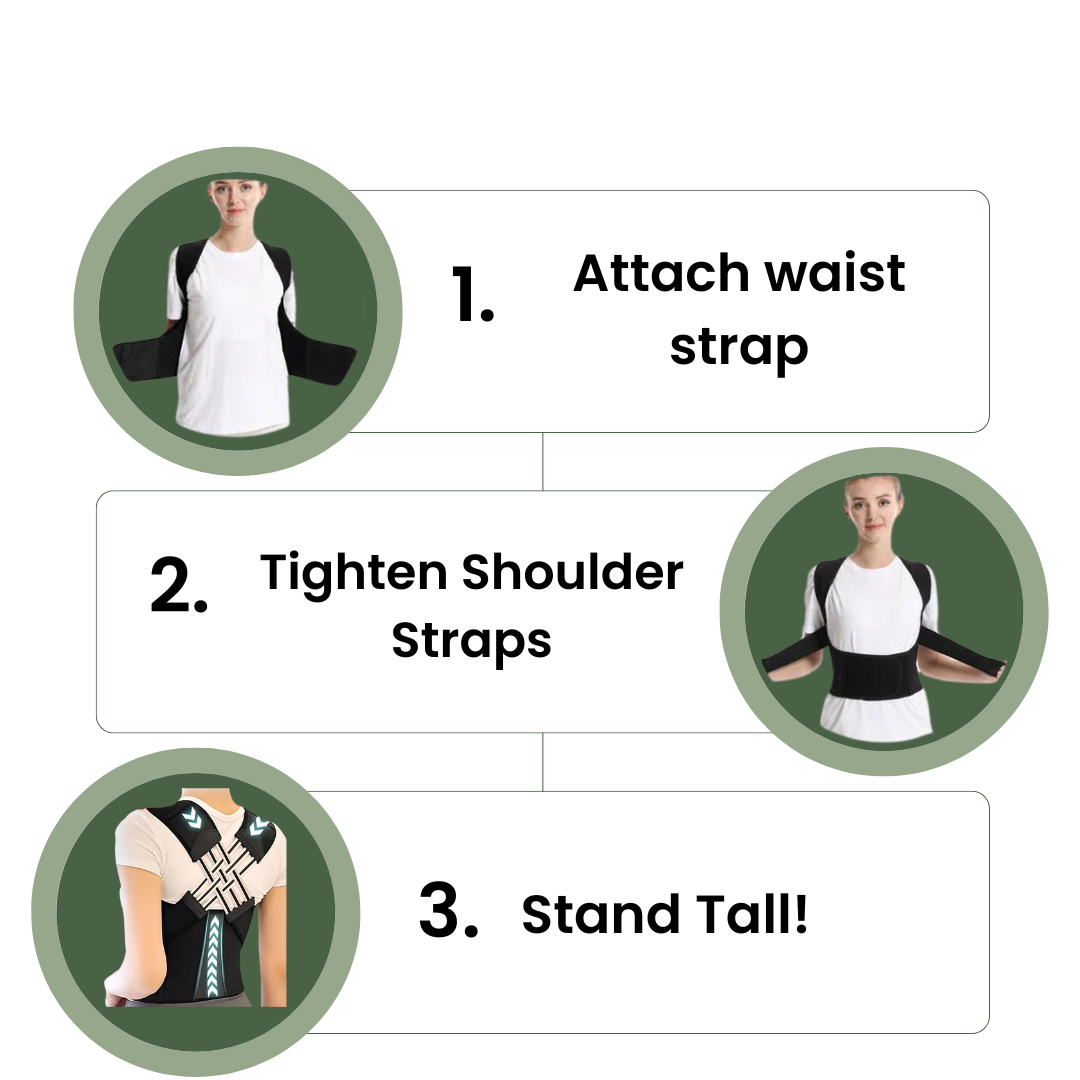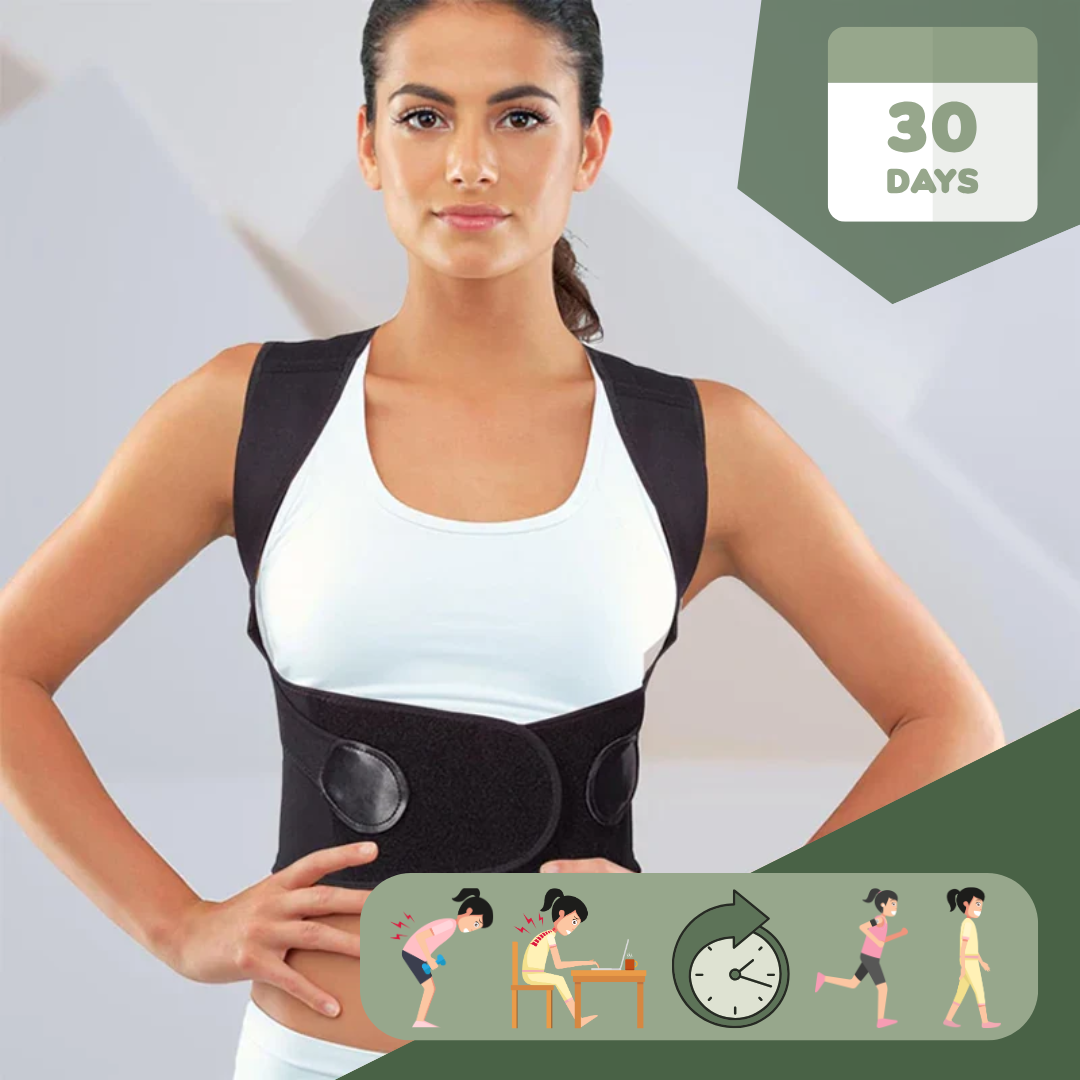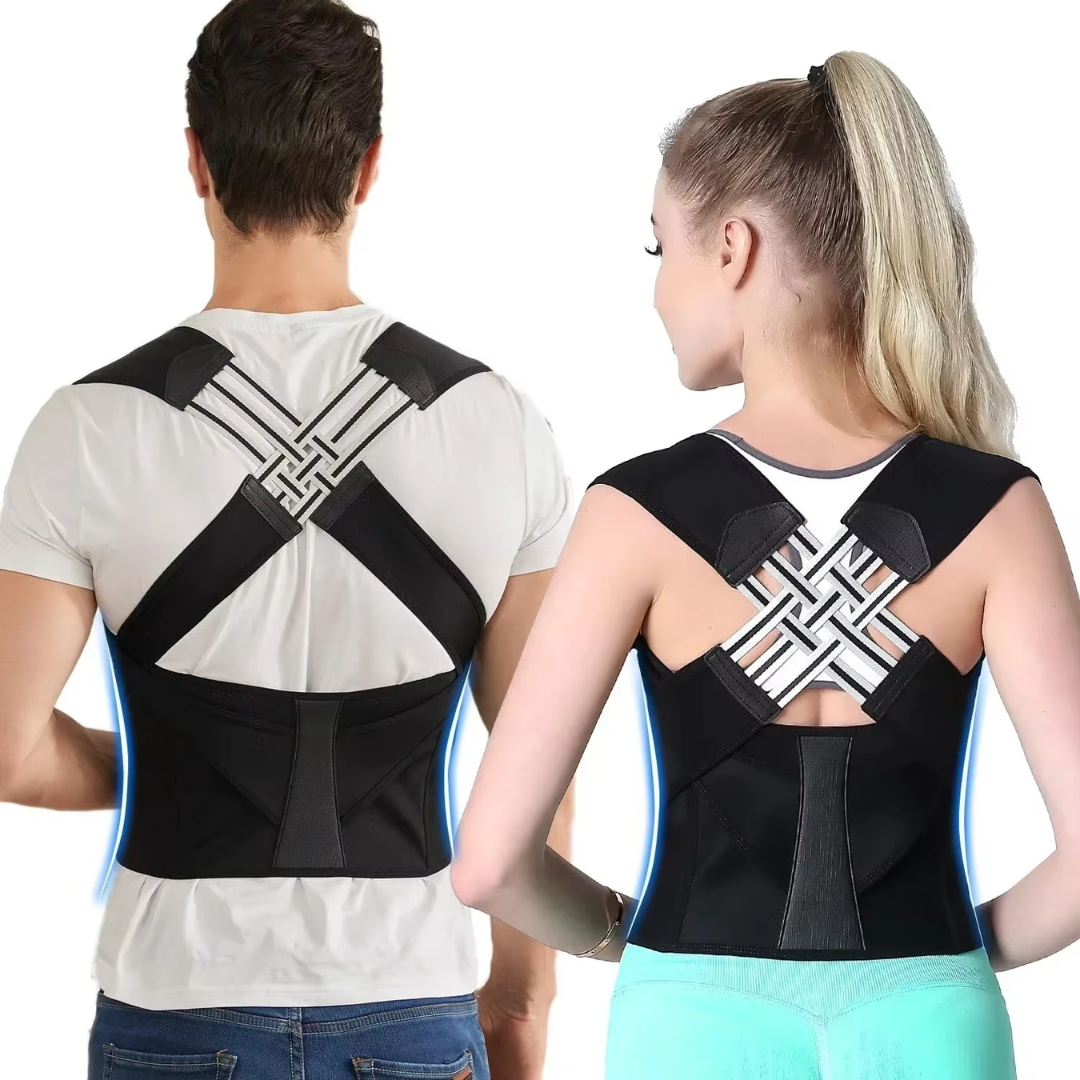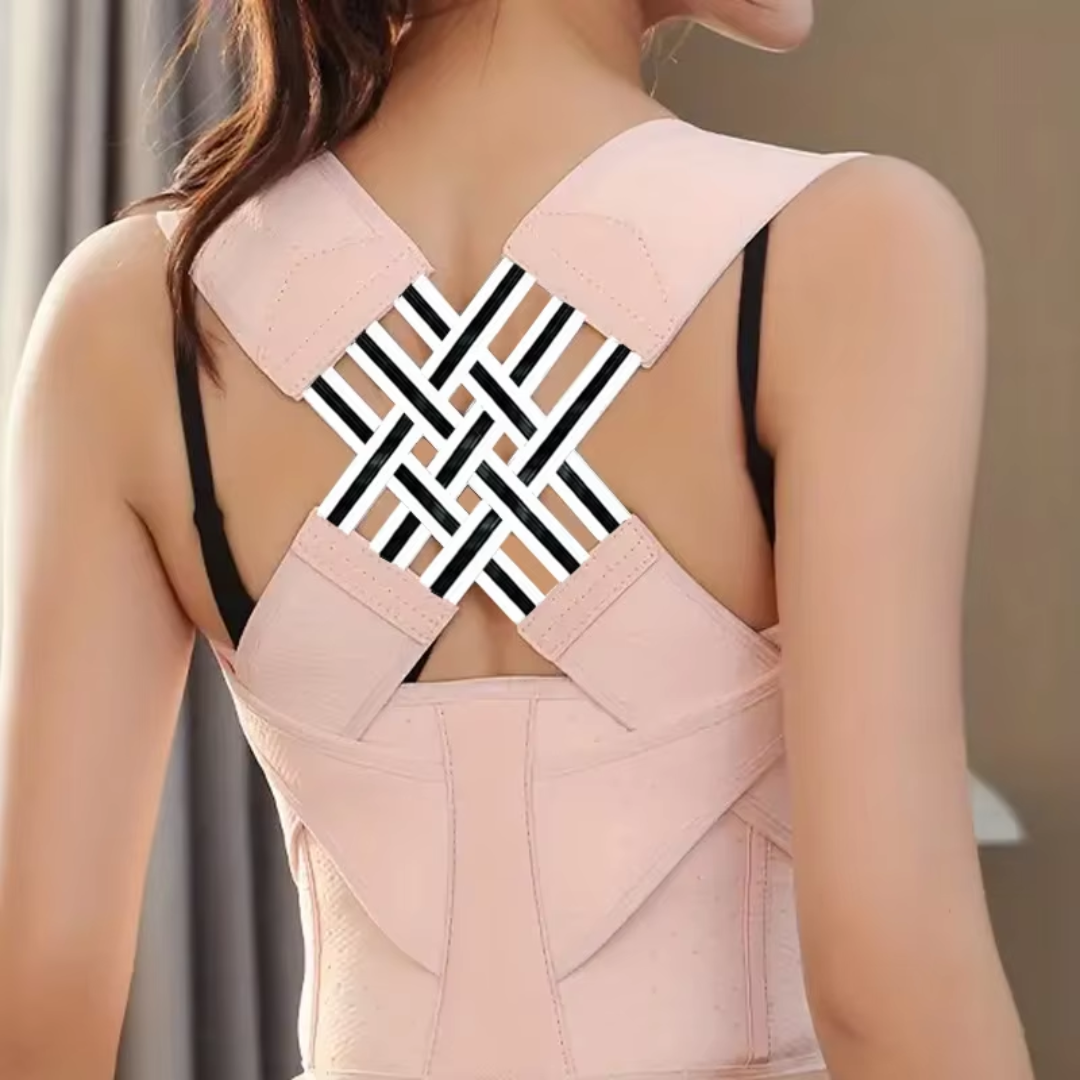Many people feel neck and back pain after using their phones or computers for a long time. This is because of the technology impact on posture. Our article will show easy ways to fix this problem and feel better.
Let's get started.
Key Takeaways
- Using technology a lot, like smartphones and computers, can cause bad posture. This leads to neck and back pain.
- Posture correctors can help fix how we stand or sit by making our spine straighter. They come as harnesses, specialized shirts, or tech devices.
- Setting up your workspace right and taking breaks to move or stretch helps prevent pain from sitting too long.
- Simple exercises that make muscles stronger are good for improving how you hold your body.
- Bad posture from using tech is common but can be fixed with some changes in habits and workspace setup.
The Impact of Technology Use on Posture

Extended use of technology devices, like smartphones and computers, often leads to poor posture. This can result in forward head posture, also known as "tech neck," and slouching that causes spinal misalignment.
Forward Head Posture (Tech Neck)
Tech neck happens from looking down at your phone or device too much. This makes neck and shoulder muscles work harder, causing pain. Your head leans forward over your shoulders, which is not good for your spine.
It stretches muscles and ligaments in the back of your neck.
This posture can lead to serious problems like chronic neck pain, rounded shoulders, and early-onset arthritis. The strain on your spine from bending it the wrong way can also cause headaches.
Tech neck shows how our devices change our bodies in bad ways if we're not careful.
Slouching and Spinal Misalignment
Slouching is bad for your spine. It pushes the lower back forward, putting pressure on it. This can lead to a lot of pain in the lower back and even slipped discs. Most people slouch without knowing when they use their smartphones or sit for too long.
Good posture is as important for your health as a good diet.
Sitting the right way keeps your spine in line. But many folks forget this when glued to screens. This habit can squash the spine, causing chronic neck pain and making shoulder pain worse.
Over time, this might turn into serious conditions like herniated discs or sciatica because of constant bad posture from sitting too much and not moving around enough.
Common Symptoms of Poor Posture Due to Technology
Prolonged use of technology can lead to symptoms like neck and back pain, as well as fatigue and muscle strain. These symptoms are often caused by slouching while using devices and can impact a person's overall well-being.
Neck and Back Pain
Neck and back pain are common problems for people who use technology a lot. This happens because looking down at screens can hurt your neck and spine. Over 30% of people feel neck pain every year, often from tech neck.
Tech neck is when you have pain or soreness in your neck or shoulders from not sitting right while using gadgets like smartphones or computers.
This kind of bad posture can also lead to other health issues, such as strained muscles and even problems with the discs in your spine. Keeping a good posture is important to avoid these pains.
It helps keep your back strong and stops the strain on your neck and shoulders.
Fatigue and Muscle Strain
Prolonged use of technology can lead to fatigue and muscle strain, especially in the neck and back. Over time, this can result in discomfort or pain that affects daily activities. Muscle fatigue may start as early as a person's 20s due to excessive screen time and poor posture habits.
"Muscle fatigue is not just about feeling tired; it impacts our everyday movements and productivity.
How Posture Correctors Can Help
Posture correctors can help by providing support for the back and shoulders, helping to align the spine in a more natural position. They can also encourage proper posture by gently reminding the wearer to maintain a straight and aligned position while sitting or standing.
Types of Posture Correctors
There are different types of posture correctors that can help improve posture.
- Harnesses: These are a common type of posture corrector that gently pull your shoulders back and align your spine properly.
- Specialized shirts: Another option for posture correction, these shirts are designed to support the back and promote proper alignment.
- Technology-enabled devices: Some posture correctors use technology to provide vibrational cues to remind you to maintain good posture throughout the day.
These methods can aid in improving posture and reducing the negative effects of prolonged technology use on the body.
Benefits of Using Posture Correctors
Using posture correctors helps in several ways:
- Improved Alignment: Posture correctors assist in maintaining a straight and aligned spine, reducing the risk of spinal misalignment and related issues.
- Reduced Pain: Using posture correctors can alleviate neck, back, and shoulder pain often associated with poor posture from excessive technology use.
- Increased Awareness: They help develop an awareness of posture, encouraging mindful habits that lead to better body positioning during prolonged technology use.
- Enhanced Muscle Support: Posture correctors provide added support to core muscles, aiding in the maintenance of good posture and preventing muscle fatigue or strain caused by extended screen time.
- Preventative Measure: By promoting proper spinal alignment and relieving stress on muscles and tendons, posture correctors act as a preventive measure against overuse injuries due to technology-related activities.
Tips for Maintaining Good Posture While Using Technology
Here are some practical tips for maintaining good posture while using technology:
- Set up an ergonomic workstation that includes a comfortable chair and an adjustable desk to support your posture.
- Take regular breaks to stretch and move around, reducing the strain on your neck and back from prolonged sitting.
- Position your computer screen at eye level to avoid constantly looking down or up, which can strain your neck muscles.
- Practice good posture by keeping your shoulders relaxed, back straight, and feet flat on the floor when using devices.
- Perform exercises targeting core strength and flexibility to support a healthy spine when consistently using technology.
Ergonomic Workstations
Ergonomic workstations are crucial for maintaining good posture and preventing discomfort. The arrangement of your desk, chair, monitor, and other tools has a significant impact on your physical well-being.
Ensure that your chair is at the right height so that your feet rest flat on the floor, with your thighs parallel to the ground. Adjust the computer keyboard so that it's directly in front of you and keeps your wrists and forearms aligned.
Also, place the monitor at arm's length with its top at or below eye level to avoid neck strain. Laptops should ideally be used with an external keyboard, mouse, and stand to improve ergonomics.
Keeping frequently used items within easy reach can also minimize excessive reaching which contributes to poor posture. Good workstation ergonomics promote better spinal health and reduce musculoskeletal pain associated with prolonged sitting and technology use.
Regular Stretching and Breaks
Technology's impact on posture is a valid concern. Here are some practical tips to counteract its effects:
- Take short breaks every 20-30 minutes to reduce discomfort.
- Include stretching exercises like neck tilts to ease tension in the neck and shoulders.
- Move every 20 minutes and walk for 5 minutes to prevent stiffness.
- Frequent movement and stretching during the workday can alleviate strain from prolonged sitting.
Keep in mind, small adjustments can make a significant difference!
The Role of Exercise in Posture Improvement
Exercise is instrumental in improving posture by strengthening essential muscles. Weak core and leg muscles can contribute to poor posture and increase the risk of exercise-related injuries.
It's essential to include regular exercise in your routine, as it helps enhance muscle strength, particularly in the core and legs, which are crucial for balance and maintaining proper posture.
Incorporating exercises like planks, medicine ball twists, and hip flexor stretches has been suggested to significantly improve posture. These exercises target various muscle groups that directly influence posture.
Moreover, practicing upright posture with eyes forward can help alleviate discomfort associated with back and neck pain. To sustain good posture over time, individuals should participate in regular physical activities such as yoga, Pilates, or weightlifting.
Conclusion
In conclusion, technology has significantly impacted our posture. Excessive use of devices can cause forward head posture and slouching, leading to neck and back pain. However, incorporating ergonomic workstations, posture correctors, and regular stretching can help maintain good posture.
It is essential to be mindful of the effects of extensive screen time on spinal health and take proactive measures to mitigate its negative impact.
FAQs
1. How does technology use lead to bad posture?
Increased screen time, especially smartphone usage, can cause a forward head and rounded shoulder posture known as 'text neck' or 'tech neck'. This is due to the repetitive motion of looking down at your device which puts strain on your spine health.
2. What are some physical issues associated with poor posture from technology use?
Bad posture from excessive technology use can lead to chronic neck pain, back pain, shoulder pain, and even conditions like carpal tunnel syndrome and cubital tunnel syndrome. These are caused by repetitive strain on certain body parts like the neck, shoulders, elbows and wrists.
3. Can physical therapy help with tech-related postural problems?
Yes! Physical therapy offers various exercises that target specific areas affected by poor posture such as strengthening your back muscles and improving flexibility in your thoracic regions. A physical therapist may also guide you through workouts aimed at correcting forward head or rounded shoulder postures.
4. Are there other health risks linked to sedentary lifestyle related to heavy technology use?
A sedentary lifestyle linked with heavy screen time not only affects our musculoskeletal system but also contributes towards social isolation, weight gain around the belly area which could affect heart health negatively if left unchecked.
5. What steps can I take myself to improve my posture while using technology?
Regular breaks from screen time for stretching or doing yoga poses like downward dog can alleviate symptoms of text-neck; adjusting workstation ergonomics so that screens are at eye level helps maintain neutral spine alignment; regular exercise including strength training for glutes and core helps support good posture overall.
6. Does reducing screen time guarantee improvement in these conditions?
While reducing screen time is beneficial in easing symptoms related to tech-induced postural issues it doesn't necessarily guarantee complete resolution particularly if you have developed conditions like carpal tunnel syndrome or stenosing tenosynovitis (trigger finger). In severe cases, medical intervention including medication like Advil or even minimally invasive procedures may be necessary.




